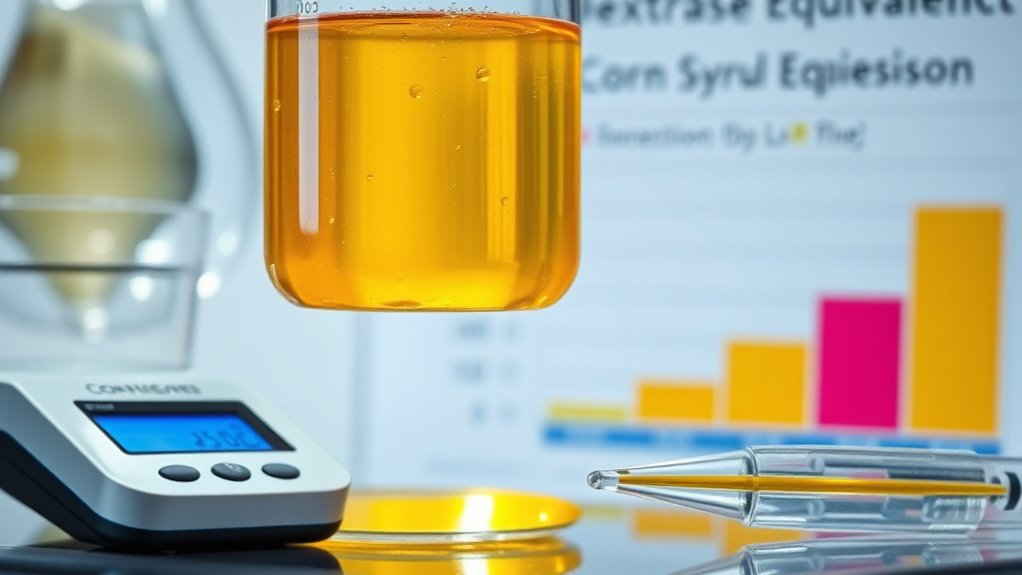Corn syrup solids are concentrated glucose-based sweeteners from cornstarch, with their properties defined by dextrose equivalence (DE). DE measures how much the syrup has been broken down into glucose; higher DE means more sweetness, solubility, and viscosity. Grading varies based on DE, affecting their application in recipes. If you want to understand how DE influences sweetness and processing, exploring more will give you a clearer picture of their role in food products.
Key Takeaways
- Corn syrup solids are graded based on dextrose content, viscosity, and moisture, with higher grades having higher dextrose equivalence (DE).
- Dextrose Equivalence (DE) measures the degree of hydrolysis of cornstarch, affecting sweetness, solubility, and functional properties.
- Higher DE indicates more glucose, resulting in sweeter, more soluble syrups, suitable for specific food applications.
- Processing techniques like enzymatic hydrolysis and drying methods influence the quality, particle size, and functionality of corn syrup solids.
- Understanding DE helps in selecting the right corn syrup grade for desired sweetness, texture, and stability in food products.

Have you ever wondered what makes corn syrup solids such a versatile ingredient in food manufacturing? It all starts with understanding their unique properties, especially how they’re graded and processed. Sweetener grading plays a pivotal role because it determines the purity, sweetness level, and functional qualities of the corn syrup solids you’re working with. Manufacturers classify these solids based on their dextrose content, viscosity, and moisture levels, which directly influence their application in various products. Higher-grade sweeteners, with a higher dextrose equivalence (DE), are sweeter and more soluble, making them ideal for candies, baked goods, and beverages. Lower grades, with a reduced DE, are used when a less sweet or more viscous ingredient is needed, such as in dairy products or certain processed foods. Understanding this grading system helps you select the right product to achieve the desired texture, sweetness, and stability. Additionally, dextrose equivalence (DE) is a key factor that impacts not only sweetness but also how the syrup interacts with other ingredients during processing. Processing techniques are equally essential in determining the quality and functionality of corn syrup solids. The manufacturing process involves enzymatic hydrolysis of cornstarch to produce glucose, followed by drying to create a stable, powdery form. During processing, controlling temperature, pH, and enzyme activity is critical to achieve the targeted DE and consistency. Modern techniques, like spray drying, ensure that the solids retain their solubility and functional properties, which are key for their performance in different recipes. Some processors also use vacuum drying or drum drying, each offering distinct advantages in terms of particle size, moisture content, and ease of dispersal. These techniques influence how well the corn syrup solids dissolve in liquids and how they behave during cooking or baking. By mastering processing techniques, manufacturers can produce consistent, high-quality ingredients that meet specific product requirements.
Frequently Asked Questions
How Is DE Measured in Corn Syrup Solids?
You measure DE in corn syrup solids through laboratory testing, which assesses the amount of reducing sugars present. This process involves specific analytical methods like polarimetry or enzyme assays to determine the sugar composition accurately. By following strict quality standards, you guarantee the DE value reflects the syrup’s sweetness and functional properties, helping you maintain product consistency and meet industry specifications.
What Industries Primarily Use Corn Syrup Solids?
You’re looking at an industry powerhouse! Corn syrup solids are mainly used in the confectionery industry and beverage formulations, transforming sweet treats and drinks into irresistible delights. They act as sweeteners, thickeners, and stabilizers, enhancing texture and shelf life. Whether in candies or soft drinks, these solids help create consistent, high-quality products. You’ll find them everywhere, making your favorite snacks and beverages even more enjoyable!
How Does DE Affect the Sweetness Level?
You’ll find that higher DE values increase sugar intensity, making products sweeter and enhancing their flavor profile. As DE rises, the sweetness becomes more pronounced, giving you a sharper, more immediate burst of sugar. Conversely, lower DE levels produce a milder sweetness, allowing other flavors to shine through. Adjusting DE helps you control the sugar intensity, ensuring the final product matches your desired taste and flavor profile perfectly.
Are There Health Concerns Related to DE?
Imagine your body as a car—too much sugar, like excessive DE, can clog the engine over time. Health impacts and nutritional concerns link high DE intake to increased risk of obesity, insulin resistance, and dental issues. While occasional consumption isn’t harmful, regularly eating foods with high DE can strain your health. Be mindful of added sugars, and opt for whole foods to keep your engine running smoothly.
Can DE Be Adjusted During Manufacturing?
Yes, DE can be modified during the manufacturing process through careful control of enzymes and heat treatment. You actively monitor quality control parameters to guarantee the desired DE level is achieved, maintaining consistency and product quality. By fine-tuning these variables, you can alter the sweetness and viscosity of corn syrup solids, ensuring the final product meets specifications and customer expectations while adhering to safety standards.
Conclusion
Understanding corn syrup solids and dextrose equivalence helps you make better ingredient choices. Remember, knowledge is power—like a key that opens better recipes and product quality. By grasping these concepts, you can confidently navigate food labels and create the treats you love. Keep in mind, a little knowledge goes a long way, and as they say, “A chain is only as strong as its weakest link”—so, stay informed and make smarter decisions in the kitchen.










